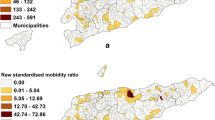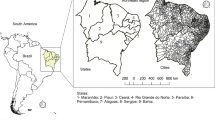Abstract
This study considers the vulnerability of the urban area of the City of Belo Horizonte to dengue. A total number of 89,607 cases registered in the surveillance system from 1996 to 2002 were analyzed. Seven epidemic waves were identified during this period. Cases were grouped into 2,563 census areas, and three risk categories were proposed based on how many times each area reached a threshold established for each epidemic wave. The association between the risk categories and the socioeconomic, demographic and urban-infrastructure characteristics was evaluated. Analysis included Kruskal–Wallis test variance comparisons and multivariate regression using multinomial models. Incidence rates differed significantly among the three risk categories in most of the epidemic waves. The factors that best characterized the areas were low educational level (≤4 years of schooling), low income of the head of the family (≤2 minimum wages per household), household density, and proportion of children and elderly women. Information related to basic sanitation was not enough to discriminate levels of susceptibility to dengue, and study of population density and concentration of establishments considered vulnerable to vector infestation yielded questionable results. It is important to consider different levels of exposure of the population to explain the heterogeneous pattern of distribution of dengue cases in an urban setting. Understanding the dynamics of dengue fever is essential for surveillance purposes, to improve control measures and to avoid epidemics of this disease.

Similar content being viewed by others
References
Kouri G. Dengue, a growing problem of health in the Americas. Rev Panam Salud Publica. 2006 Mar;19(3):143–145.
Gubler DJ. Epidemic dengue/dengue hemorrhagic fever: a global public health problem in the 21st century. Dengue Bull [serial online] 1997;21:1–15. Available at: http://w3.whosea.org/en/Section10/Section332/Section519_2380.htm. Accessed on January 30, 2004.
Tauil PL. Aspectos críticos do controle do dengue no Brasil. Cad Saúde Pública. 2002;18(3):867–871.
Teixeira MG, Barreto ML, Guerra Z. Epidemiologia e medidas de prevenção do dengue. Inf Epidemiol SUS. 1999;8(4):5–33.
Pinheiro F, Nelson M. Re-emergence of dengue and emergence of dengue haemorrhagic fever in the Americas. Dengue Bull [serial online] 1997;21:16–24. Available at: http://w3.whosea.org/en/Section10/Section332/Section519_2381.htm. Accessed on January 30, 2004.
Gómez-Dantés H, Ramos-Bonifaz B, Tapia-Conyer R. El riesgo de transmisión del dengue: um espacio para la estratificación. Salud Pública Méx. 1995;37(suppl):88–97.
Escobar-Mesa J, Gómez-Dantés H. Determinantes de la transmisión de dengue en Veracruz: un abordaje ecológico para su control. Salud Pública Méx. 2003;45(1):43–52.
Koopman JS, Prevots DR, Vaca-Marin MA, Gomez-Dantés H, Dorate AML, Longini MI. Determinants and predictors of dengue infection in Mexico. Am J Epidemiol. 1991;133(11):1168–1178.
Costa AIP, Natal D. Distribuição espacial da dengue e determinantes socioeconômicos em localidade urbana no Sudeste do Brasil. Rev Saúde Pública. 1998;32(3):232–236.
Teixeira MG, Barreto ML, Costa MCN, Ferreira LDA, Vasconcelos P. Dinâmica de circulação do vírus da dengue em uma área metropolitana do Brasil. Epidemiol Serv Saúde. 2003;12(2):87–97.
Medronho R. Geoprocessamento e saúde: uma nova abordagem do espaço no processo Saúde Doença. Rio de Janeiro: Fundação Oswaldo Cruz; 1995.
Bohra A, Adrianasolo H. Application of GIS in modeling of dengue risk based on socio-cultural data: case of Jalor, Rajasthan, Indian. Proceedings of the 22nd Asian Conference on Remote Sensing 2001 Singapore. Available at: http://www.crisp.nus.edu.sg/~acrs2001/pdf/096bohra.pdf. Accessed on December 2, 2003.
Morrison AC, Getis A, Santiago M, Rigau-Perez JG, Reiter P. Exploratory space-time analysis of reported dengue cases during an outbreak in Florida, Puerto Rico, 1991–1992. Am J Trop Med Hyg. 1998;58(3):287–298.
Barrera R, Delgado N, Jiménez M, Villalobos I, Romero I. Estratificación de una ciudad hiperendémica en dengue hemorrágico. Rev Panam Salud Pública. 2000;8(4):225–233.
Correa PRL, França E, Bogutchi TF. Aedes aegypti infestation and occurrence of dengue in the city of Belo Horizonte, Brazil. Rev Saúde Pública. 2005;39(1):33–40.
Brasil. Ministério da Saúde, Fundação Nacional de Saúde, Departamento de Operações. Manual de dengue-vigilância epidemiológica e atenção ao doente. Brasília (Brasil): DEOPE; 1995.
Barcellos C, Pustai AK, Weber MA, Brito MRV. Identificação de locais com potencial de transmissão de dengue em Porto Alegre através de técnicas de geoprocessamento. Rev Soc Bras Med Trop. 2005, maio/jun; 38(3):246–250. ISSN 0037-8682.
Hosmer DW, Lemeshow S. Applied Logistic Regression. New York: John Wiley and Sons; 2000.
Victora CG, Huttly SR, Fuchs SC, Olinto MTA. The role of conceptual frameworks in epidemiological analysis: a hierarchical approach. Int J Epidemiol. 1997 Feb;26(1):224–227.
Favier C, Schmit D, Muller-Graf CDM, et al. Influence of spatial heterogeneity on an emerging infectious disease: the case of dengue epidemics. In: Proc R Soc B. 2005 Jun 7;272(1568):1171–1177.
MapInfo Professional [computer program] MapInfo Corporation: New York: Troy Applied innovations; 2001.
SPSS [computer program] SPSS Inc; 1999.
Teixeira MG, Costa, MCN, Barreto ML, Mota E. Dengue and dengue hemorrhagic fever epidemics in Brazil: what research is needed based on trends, surveillance, and control experiences? Cad Saúde Pública. 2005;21(5):1307–1315.
Pessanha JEM, DiLorenzo C, Costa MA, et al. Dengue seroprevalence in Belo Horizonte: detecting participation bias through spatial analysis methods for small-area studies. In: The Second Annual International Conference on Urban Health, October 15–18, 2003. J Urban Health. 2003;80(Suppl 2)ii29.
Carvalho MS, Cruz OG. Análise espacial por microáreas: métodos e experiências. In: Veras RP, Barreto ML, Filho PA, Barata RB, eds. Epidemiologia contextos e pluralidade. Rio de Janeiro: Fiocruz/Abrasco; 1998:79–89.
Acknowledgments
We would like to thank Paulo Roberto Lopes Corrêa for reviewing data from 1996 to 2001, after data checking and validation.
This study is part of a Master’s degree dissertation, of the Master’s degree course in Public Health, Universidade Federal de Minas Gerais. It was approved by the Institutional Review Board/Research Ethics Committee of the Universidade Federal de Minas Gerais (COEP No. 233/03). The last three authors are recipients of Brazilian National Council for Scientific and Technological Development (CNPq) scholarships.
Author information
Authors and Affiliations
Corresponding author
Additional information
de Mattos Almeida is with the Municipal Health Secretariat of Belo Horizonte, Belo Horizonte, Minas Gerais, Brazil; de Mattos Almeida, Caiaffa, and Proietti are with the Urban Health Observatory, Universidade Federal de Minas Gerais (UFMG), Belo Horizonte, Minas Gerais, Brazil; Caiaffa and Proietti are with the Research Group in Epidemiology (GPE/CNPq), Department of Social and Preventive Medicine, Universidade Federal de Minas Gerais (UFMG), Belo Horizonte, Minas Gerais, Brazil; Assunc¸a˜o is with the Department of Statistics, Universidade Federal de Minas Gerais (UFMG), Belo Horizonte, Minas Gerais, Brazil.
Rights and permissions
About this article
Cite this article
de Mattos Almeida, M.C., Caiaffa, W.T., Assunção, R.M. et al. Spatial Vulnerability to Dengue in a Brazilian Urban Area During a 7-Year Surveillance. J Urban Health 84, 334–345 (2007). https://doi.org/10.1007/s11524-006-9154-2
Published:
Issue Date:
DOI: https://doi.org/10.1007/s11524-006-9154-2




